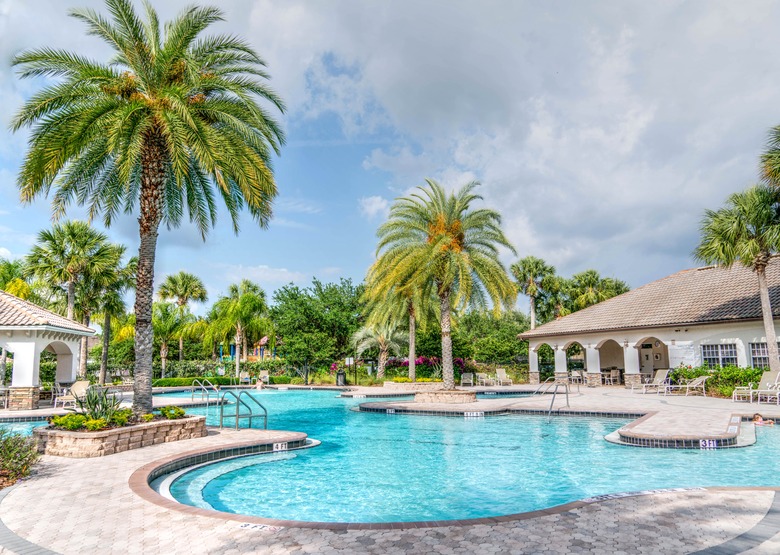How To Kill Brown Algae In A Pool
The bad news first: Brown algae clinging to the sides of a swimming pool is one of the more difficult types of algae to eliminate. Brown-colored algae is actually a form of yellow or mustard algae, and not a separate strain of its own. The extremely rare mustard algae forms in pools with poor chemical balance and in shaded areas that get little sun. Now for the good news: Even the most stubborn brown algae is no match for a homeowner with the tenacity and time to eradicate it.
A Three-Part Strategy
A Three-Part Strategy
Brown algae may be resistant to chlorine to a degree, but high concentrations of the sanitizing chemical will kill even stubborn algae. Consequently, shocking the pool is a good way to get rid of it, but before you do that, you have to put in some manual labor. To free the algae from the sides and bottom of the pool, you have to vigorously brush it to get it suspended in the water, where the chlorine can reach it.
Before you shock the pool, you need to adjust the pH, because chlorine doesn't work well in alkaline water. If the pH is above 7.8, use muriatic acid or sodium disulfate, as needed, to bring it into a a range between 7.2 and 7.6. At the same time, lower the total alkalinity, if necessary, to a range between 85 and 100 parts per million, using the same chemicals.
After shocking, the pool water will likely be cloudy, so use a flocculent to clarify the water and congeal any algae particles that may have survived. After the sediment has fallen to the bottom of the pool, vacuum it to waste.
Pool Shock Chemicals
Pool Shock Chemicals
The purpose of shocking is to raise the chlorine concentration to 10 ppm or more, and you can do this with a number of chemicals. Lithium hydroxide and calcium hydroxide do it quickly, but most homeowners use sodium hydroxide in the form of pool chlorine or household bleach. The concentration in bleach is less than half what it is in pool chlorine, so you need twice as much.
Before adding sodium hydroxide, check the cyanuric acid concentration; if it's less than 30 ppm, add pool stabilizer to raise the cyanuric acid levels to between 30 and 50 ppm. You can also shock with dichlor tablets, which contain a stabilizer.
How to Kill Brown Algae
How to Kill Brown Algae
This step-by-step procedure for killing brown algae also works for green and black algae, which are the other types of algae that grow in pool water.
Things Needed
-
Pool testing kit
-
Pool brush
-
Leaf rake
-
Pool shock treatment
-
Algaecide
-
Flocculant
Step 1
Test the pool's water using a pool testing kit. Add chemicals as necessary to adjust the pool's pH level to between 7.2 and 7.6, the alkalinity level to between 85 and 100, and the water hardness to between 150 and 250 ppm.
Step 2
Add enough chlorine to your pool to bring the free chlorine concentration to between 1 and 3 ppm. Follow the application directions on the product labeling.
Step 3
Clean the pool's filtration system once the chemical levels are balanced. Adjust the settings to circulate the water constantly until the algae is removed. Backwash the filter twice per day.
Step 4
Scrub the sides and bottom of the pool vigorously using a long-handled pool brush. Remove as much algae as possible, especially over the drains and valves in the pool. Collect the loosened algae using a pool leaf rake afterward.
Step 5
Shock the pool to weaken the algae. Raise the chlorine levels to at least 10 ppm. If the algae problem is severe, double-shock to raise the chlorine level to 15 or 20 ppm. Add the chlorine in one application, rather than several gradual installments. Always shock in the early evening to prevent sunlight from instantly degrading the chlorine.
Step 6
Wait for the chlorine concentration to fall to 5 ppm, then add an algaecide formulated to kill yellow or mustard algae to the pool. Follow the directions on the labeling. Give the algaecide time to work before doing anything else.
Step 7
Scrub the sides and bottom of the pool again to remove the remaining algae. Add pool flocculant, and allow the sediment to settle to the bottom of the pool. Vacuum it to waste.
Step 8
Continue circulating the water in the pool, scrubbing algae and backwashing the filter until all of the brown-colored algae is gone.
Step 9
Clean or replace the filter twice per day until the algae problem is definitely gone for good. Resume swimming in the pool once chlorine levels reach 1 to 3 ppm.
Tip
Keep the pool's pH, alkalinity and hardness levels balanced, and clean the pool regularly to prevent brown algae from recurring in the future.
